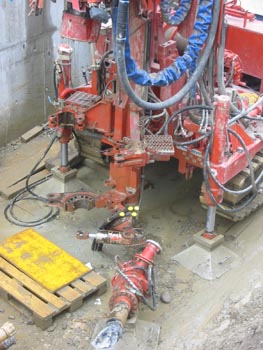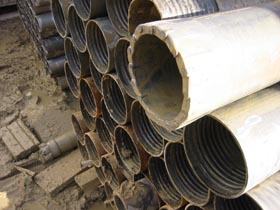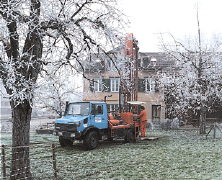- Start / Language
- HHO powered Powerplant
- HHO Systems in Cars
- Geothermal Energy
- Geotherm in Romania
- Partner and Links
- Sponsoring
Terrestrial
heat probes (THP)
Detailed information
1. Installation of THP
The necessary drilling for the installation of a terrestrial heat probes takes place in depths from 50 to 400m, since within this range no more daily or seasonal variations in temperature arise. The diameter of the drilling can amount to up to 160 mm.
A THP just needs a very little place on the surface, - in contrast to horizontal probe-registers - and offers highest achievement and efficiency.
For example, the potencial thermal achievement, with a yearly run-time of 2'400 hours, in a average compact rock or in a fully filled water-sediment is about 40 to 60 W per meter. For horizontal terrestrial probe-registers, results only 16 to 24 W per square-meter surface.
A terrestrial heat probe generally consists of 2 pressure-steady plastic U pipes (polyethylene - PE), in which a heat transfer liquid circulates.
If the ground condition is not well known, it's advisable to ask help from a geologist or a hydraulic geologist. Together with the Heater installator he will will specify the necessary depth of the terrestrial heat probe in dependence of the heat requirement. The dimensioning of a terrestrial heat probe/heat pump system is of a high importance within a terrestrial heat probe project and should be clarified before requesting the drilling grant.
2. Grant procedure

For reasons of the ground-water protection, to keep actual and potentional
drinking water, there are areas, where drillings are not allowed.
Near Dumps or or contaminated locations, drillinngs are generally forbidden. This way can be asured the conatmination between the dirty surface with the drinking water in deeper Aquifers.
In certain regions there can be a restriction of the drilling depth for geological or hydraulic-geological reasons. In order to achieve the same thermal achievement, two drillings of a smaller depth which do not exceed the existing depth limit, can be done.
In areas, in which the ground is unstable, drillings are forbidden, since the intactness of the heat exchanger cannot be ensured on a long term.
3. Importance of a professional technical execution
After bringing in the PE-Rohre, the remaining gap between the pipes and the edge of the drilling is filled completely by injecting a suspension from Bentonit and cement. Thus a good thermal contact between terrestrial heat probe and ground is ensured and the risk of unwanted water river along the heat exchanger pipes is avoided. The injected suspension is pressed in by an auxiliary pipe from the bottom of the drilling hole and is spreaded from there upward. Specialized enterprises execute the drillings and the placement of the tubes according to certain quality criterias.
4. THP and heat pump (HP), a profitable team
The terrestrial heat probe is getting the heat via the surface of the drilling holes which is the contact to the underground.
The used heat transfer liquid normally consists of a water glycol mixture (Brine), in order to avoid freezing of the transfer liquid, due to a too optimistic dimensioning in relation to the real heat requirements.
With the help of a heat exchanger the energy is transferred into the working-medium cycle of the heat pump. During the normal run the temperature difference between inlet and outlet of the pipes (2 to 4 K) should be as little as possible, which requires a higher flow rate of the heat transfer liquid.
The underground delivers approx. 75% of the usable heat-energy on the outlet of the heat-pump. The remaining 25% are supplied to the heat pump in form of electricity. Further illustration: a Heater, driven 100% with electricity, is using 100% electrical energy to produce heating energy. Thanks to the terrestrial energy, the current consumption in a THP/HP environment can be reduced by about 75%, compared to a 100% electrical heating system.
5. Depth of THP, heating and cooling
 With
a terrestrial heat probe of about 150 to 200 m length, it is actually
possible to heat a family house and to cover the complete need of warm
water of this house.
With
a terrestrial heat probe of about 150 to 200 m length, it is actually
possible to heat a family house and to cover the complete need of warm
water of this house.
With deeper terrestrial heat probes, pure water can be used instead of the water antifreeze mixture (brine), since a heat source with higher temperature is at the disposal to the heat transfer liquid . In consideration of the ground-water protection, this can be of a high importance.
The potential thermal achievement per meter of probe-length depends significantly of the surrounding rocks and the presence of water. Certain rocks, as e.g. tight and substancial limestone and other water-saturated sandstones gives a very good heat conductivity. Dry sand or clay/tone have a much worse heat conductivity.
For a given heat achievement, the length of the THPs relates to the altitude of the building, the vertical succession of the geolocical horizons and its water-saturation (dry or humid).
For a probe length of less than 200 m it is possible to use the underground in summer as a cooling source. At this moment the heat-pump is not running, but just the circulation pump ensures that the heat-transfer liquid is circulating in the tubes, to use the cold soil, produced during winter-time. The surplus warmth from a building, won thereby, contributes to the thermal reloading of the underground.
While single terrestrial heat probes usually only are used for heating family houses, [terrestrial heat probe fields] uses the undergroundground at the same time for heating and cooling large buildings.
6. THP and WP, also with building renovation integrable!

With total renovation of a building, it is worth to examine whether the
installation of a THP coupled to a WP ispossible.
Initially for low-temperature heaters developed (floor heatings), there are nowadays heat pumps, which produce temperatures from 50 to 60 °C. They permit it to heat reconditioned houses, which are equipped with radiators, with high efficiency.
Considered increasing the energy efficiency of a building, different parameters must be referred before installation of a THP or a completely new heating system. Nowadays the goal should contain no longer only the “classical” renovation of the building.
In order to lower the energy consumption and to correctly dimensioning the THP and the HP, it is necessary, depending on the building size, to improve the energy efficiency: isolation of the roof, isolation of the fundament, basement, the isolation of the living rooms on the out- or the in-side and the exchange of old windows with modern energy-saving glass.
Heating savings are very important. Certain changes only need a small investment, compared to the savings on a mid-term or long-term, specially caused by the significant reduction of the operating costs.
I
7. Investment- and operating - cost
The costs of a terrestrial heat probe depend of several factors. Under normal conditions the costs for an individual probe are about 40.- to 60.- Euro per probe meter or about 110.- Euro if the cost for a heat-pump and the connection to the THP are included.
A total balance is necessary, in which all additional investment-costs as well as the annual energy costs are included. In consideration of the respective project conditions, favourable total operating cost and stable production costs for the supplied warmth will result on a long term.
Each plant is different. During an investment- and an operating cost estimate, of course must be paid attention to the fact, what energy reference is present and on what the estimates of warmth and/or warm water requirements are based on.
8. Pro and cons /Limits
Restrictions can occur e.g. by the geological ground condition, by possible restrictions due to the ground-water protection or because of instability of the underground, which does not ensure the soundness of the THP on a long term aspect, and by other aspects addressed before. Exceptionally, where these restrictions are taking place, with correct dimensioning of the THP and the HP there are only a few disadvantages:
The house must be directly attainable by a road, in order to bring the drilling equipment and all needed material to the construction place.
Das Haus muss durch eine Strasse direkt erreichbar sein, um die Bohrgeräte und alles, benötigte Material auf den Borhlatz zu schaffen.
The advantages of the use of terrestrial heat are however numerous:
From practical view seen, the necessary place for the drilling work is
minimal and the drilling duration short: only about 1 to 2 days, dependent
of the necessary drilling depth. If the THP is then connected with the
heat pump, there is nothing visible anymore at the earth's surface. The
place some HP need is limited to the Heatingroom of the building (similar
to the size of a washing machine).
If a HP is replacing an oil heating systemor in case of a new constructed
building, the place needed before can then theoretically be used for
other purposes. Besides, houses, for which a THP/HP is intended, don't
have to be equipped with a chimney.
From the technical point of view, the 30 years experience of the heat pump manufacturers for family houses leads to a reliable service, whose efficiency constantly increases. The certified enterprises guarantee in this matters a professional completion of the work.
Moreover, on a mid-term view, this technology is very economically profitably, since the investement costs are balanced normally afetr some years. In places with high electricity costs it takes a maximum of 10 years.
Considering the advantages concerning the environment, a combination of terrestrial heat probe and heat pump, permits to get along without fossil fuels like oil and gas. This solution produces neither CO2 nor fine dust. A terrestrial heat probe/heat pump system makes independent of the uncertainties, which are coming along with the limited availability of fossil fuels. A certain dependence of the electricity tariff remains existing nevertheless, however the trend of costs is better to foresee and less of the world-political events certainly